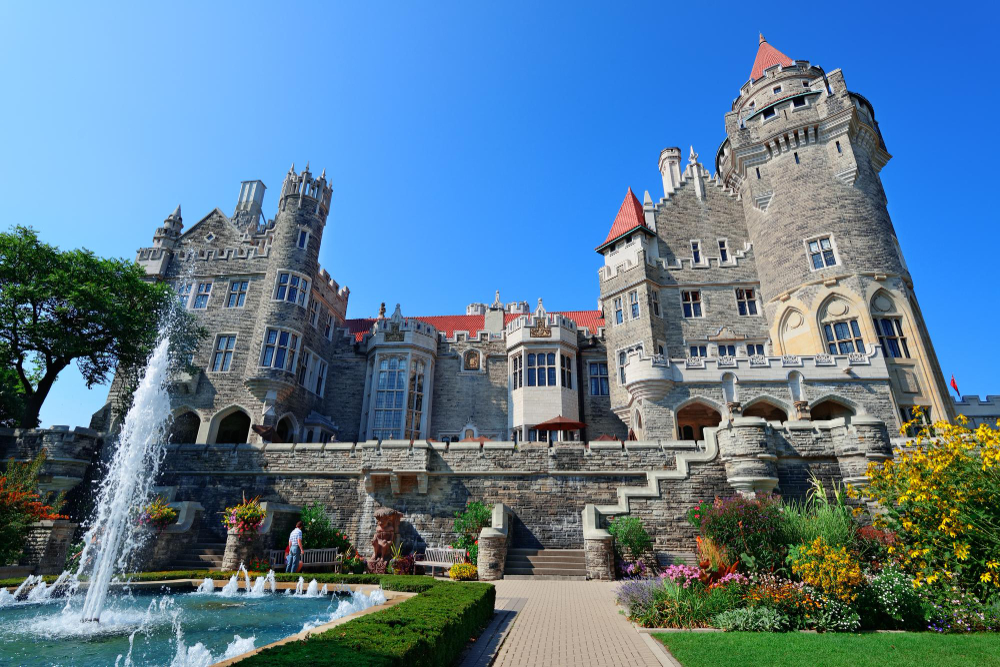Toronto is a city that thrives on history. Even though Canada’s largest metropolis might not be considered “old,’ it includes a mix of distinct neighbourhoods that have a historic legacy with a vibrant street scene that’s worth exploring.
If you have ever wanted to learn more about Toronto’s rich architectural heritage, consider these must-see sites to discover its past.
Casa Loma
Majestic and slightly terrifying, Casa Loma is a 64,700-square-foot castle that is now a popular museum. Built in 1914 for Sir Henry Mill Pellatt, Casa Loma is now an iconic location for filming movies and TV series. The castle is open to the public, offering an exquisite glimpse into its stately 98 rooms with opulent paintings, furnishings, and grand library. If you stroll through the castle’s vast expanse, you can climb up the narrow staircases to the top of its gothic towers for majestic views of Toronto’s skyline. Inspired by Europe’s castles, Sir Henry Pellatt hired stonemasons from Scotland to build Casa Loma. After the Pellatt’s moved out, Casa Loma became a hotel and nightclub frequented by wealthy Americans in Toronto looking to consume alcohol legally during the Prohibition Era. The castle has an 800-ft underground tunnel rumored to be the home of a ghost with strange noises.
Osgoode Hall

Named after William Osgoode, the first Chief Justice of Upper Canada, Osgoode Hall was the headquarters of the Law Society of Canada since its inception in 1832. In 1979 Osgoode Hall was designated as a National Historic Site, because it represented the judicial institutions in Ontario, and protected underground railroad refugees from extradition. With a commanding presence in Queen Street West, Osgoode Hall has a distinctive library, Rotunda, and a wood-paneled dining room with an opulent ambiance. Since 1846, Osgoode Hall has housed the highest courts in Ontario and is still used as a courthouse for the Ontario Court of Appeal, and the Superior Court of Justice. During summer, the Law Society of Ontario offers guided tours, which grants access to the atrium and library, presenting exquisite views of its unique architectural heritage.
Queens Park Ontario Legislature

The Ontario legislative building has a rich historical legacy. Construction on the building started in 1886 and was completed in 1909. The five-storey building was designed by Richard Alfred Waite, a British-born American architect. The building is made of millions of bricks constructed by inmates of the Central Prison of Ontario. With various stone carvings, including gargoyles, grotesques, and friezes, the legislature has a unique rustic finish punctuated by large windows and iron structures. The East Wing houses the government departments, and has elaborate walls lined with oak paneling. The West Wing has a stained-glass ceiling featuring the Ontario Coat of Arms complemented by Italian marble floors.
Gooderham Building (Flatiron)

The five-storey building with a wedge-like structure sits on a pristine triangular corner of St. Lawrence Market District. It is one of Toronto’s most photographed buildings and is only a few blocks away from St. James Cathedral. Originally owned by the Gooderham family, the eldest son of the Gooderham family commissioned architect David Roberts Jr. to construct a building slightly west of the industrial complex to house the family’s Worts Distillery business. The building served as the office of the Gooderham Worts distillery business until 1952. It was sold by the family in 1957. Considered a marvel of architectural design, it has styles reminiscent of Romanesque and Gothic Revival designs. Its interior features a large trompe l’oeil wall mural, and several significant architectural attributes, including Toronto’s oldest electric elevator.
Union Station

Located on Front Street West, Union Station is Canada’s busiest station. Being an architectural icon, Union Station is designed after the sweeping Beaux-Arts style by a team of architects composed of the Montreal firm—G.A Ross and R.H MacDonald. Initially, construction on the station started in 1913 but was delayed because of World War I. The station officially opened in 1927. As the home and central hub of GO Transit’s commuter rail services along with VIA Rail and Amtrak services; the station serves over 200,000 travellers a day. Union Station has been a National Historic site since 1975. The station’s unique architectural structure features Corinthian columns made of limestone. The Great Hall and Main Concourse are diffused with natural light, thanks to the clerestory windows spread throughout the expansive lobby. Like the exterior structural façade, bronze, limestone, marble, tiles, and translucent glass add to its uniqueness.
Aaron Levinson | Staff Writer










